Discover Underwater Grass that actually Flowers … Seagrass!

Greetings! That’s right, seagrass actually flowers! And as you may already know, it is the favorite food of us manatees! Even though it’s called, seagrass, seagrasses are actually not “grasses” at all because they flower! And just like land plants, seagrasses produce beneficial oxygen. Since seagrasses need light to produce photosynthesis, just like land plants, they are found in shallow water in several parts of the world. This is so the sunlight can reach the seagrasses and penetrate their cells. In fact, seagrasses can be found in the tropics all the way up to the Arctic Circle!
Why is it called seagrass?
This is because of the many colors of green found on their long grass-like leaves. Also, many times seagrasses are confused with seaweeds. However, seagrasses have roots, stems and leaves, and they also produce flowers and seeds. Seagrasses belong to a certain group of plants called monocotyledons, which include grasses, lilies and palms. Additionally, seagrasses have a vascular system that transports both nutrients and water in their system. Seaweed on the other hand, is actually algae living on the seafloor. Seaweed has a holdfast in the sand to secure it and they transport nutrients through their system by diffusion.
Seagrasses are approximately 100 million years old and there are currently 72 different types in the world. Interestingly, seagrasses can create very dense underwater meadows. In fact some of these meadows are so large they can be seen from space!
As one of the most productive ecosystems in the world, seagrasses often receive very little attention. This is very unfortunate because seagrasses are shelters and food for a very large community of animals. These include tiny invertebrates all the way up to large fish, crabs, turtles, manatees and birds.
Seagrass and its Ecosystem Benefits
Many times seagrasses are called the foundation plant species because of the way they modify their local environments and create very unique habitats. As of us manatees, we get a good variety of food from this! Also, humans have been using seagrasses in their daily living for more than 10,000 years! How? Humans use seagrasses for fertilization in fields, insulation in homes, for furniture weaving, thatching roofs, and filling mattresses along with car seats!
However, it is what seagrasses perform in their local habitat that actually has the biggest benefits for both humans and the oceans. You see seagrasses help commercial fisheries and also biodiversity by cleaning the water and removing carbon dioxide [CO2] from the atmosphere. As a result of these extraordinary benefits, seagrasses are now believed to rank as the third most valuable ecosystem in the world! Only estuaries and wetlands precede them. Interestingly, about one hectare of seagrass, which is the area of two football fields is currently estimated to be worth over $19,000 per year! This makes seagrasses “one of the most valuable ecosystems” in the world!
If you see any sick or injured manatees, please call the Florida Fish and Wildlife Conservation Commission at: 1-888-404-FWCC. They are the folks who are responsible for rescuing us in Florida.
Here’s the Save the Manatee Club link to learn more about us manatees …
Here’s a cool link for you to learn more about how we’re rescued and brought into rehabilitation …
~ Kobee Manatee
Related Posts
“Seagrass Can Store Carbon for Centuries, Millennia” – Dr. Oscar Serrano (February 4, 2016)